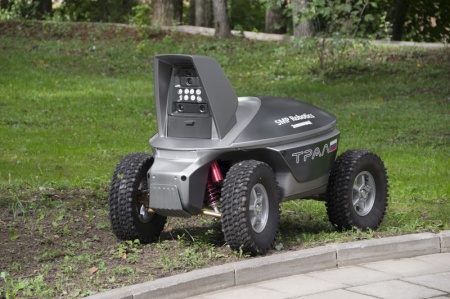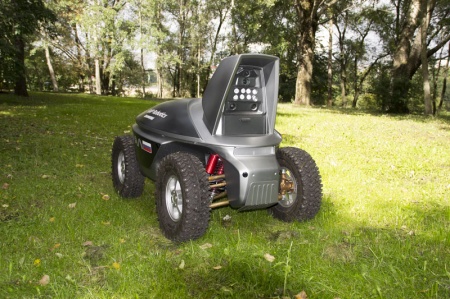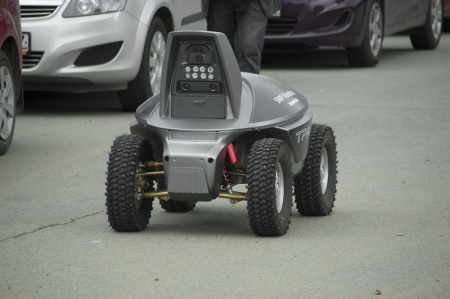SRX 1
Specification
| Height | 1370 mm |
| Width | 930 mm |
| Thickness | 765 mm |
| Weight | 120 kg |
| Case | Metal |
| Modifications | In stock in | Qty | Buy | |
| USA | Russia | |||
Select modifications
Description
SRX 1 - wheeled robot for prepared paths of travel
SRX 1 UGV Unmanned Ground Vehicle is used for autonomy navigation across ground or any other prepared terrain. Video navigation system is fully autonomous and does not require operator's control. Route planning is carried out according to the images from the built-in cameras. This helps it to achieve high precision of navigation. The wheeled robot can be applied in sidewalks with the width of 0.8 m. Video navigation system provides detection and avoidance of obstacles with further return to the route specified.
The robot is capable to perform automatic navigation both in the daytime and at night. It features rear-wheel electric drive with differential. For winter time, it is completed with studded tires.
The wheeled robot is powered from three built-in rechargeable batteries. When discharged, the robot automatically returns to get charged. To power actual load there is 55 A/h 12 V released.
|
Operating range at +5°С |
25 km |
|
Driving speed in the automatic mode |
4-7 km/hr |
|
Nominal payload capacity | 35 kg |
|
Optimal width of driving path |
1.1 m |
|
Wheel diamerer |
420 mm |
|
Dimensions, width×height×length |
765x930x1370 mm |
|
Gross vehicle weight |
120 kg |
|
Nominal operating temperature range |
-30°C°…+55°C |
The ideal habitat of this wheeled robot is a park area with a network of paths being not overcrowded with personnel, visitors, vehicles and other random obstacles. The fact is that the robot navigates according to the route shown in the first drive, and each time an obstacle appears in this familiar route, the robot will have to find bypass routes, and this is not a familiar route, and therefore needs to be explored.Of course over time, it is going to build up a complete map of the area, but in this case, the way from point A to point B will take uncontrolled amounts of time and energy. Therefore, it would be better to create optimal conditions for the operation of this vehicle robot, so that it can carry out the assigned tasks at night or choose driving routes with minimum obstacles in it.
Wheels of the robot, as well as its suspension and placement of cameras of video navigation system ensure smooth navigation on flat surfaces of driveways paths, lawns, paved areas. Moreover, the paving material is not that important, tires selected are very flexible featuring optimal catchy properties. The main thing that should be noted is that the surface should be quite flat, as the device should not be applied on a ploughed field. The most difficult operating conditions occur in winter, and it's not so much due to the low temperatures and a decrease in the number of visible targets, because of their mass burial under the snow, but due to the amount of snow on the tracks. Soon after the second snowfall, there is practically no chance for this robot to navigate through the snow-covered lawn. Things get really better in pathways, provided they are cleared off snow. After using a manual snow-removing machine, the robot can move smoothly due to the soft rubber and the protector's properties. For smoother operation in case of frequent night frosts and thaws, studded tires can be applied.
SRX 1 Robot is completely independent, but the device also presupposes the interfaces to communicate with the operator. Primarily, that is a tablet computer, which is connected to the vehicle robot via WiFi or cellular network. The tablet is used to display the location of the remote robot, indicating its status, change or assignment of navigation tasks. All the available operations can be carried out using a tablet. Besides it, the package includes industry-standard radio remote control. If the tablet is on the operator's workplace, the remote control can easily be used outdoors in rain or snow, frost or heat. It may be required in two cases.
First when you need to take the robot for the first drive, so that it saves the route. The operator manipulating joysticks, slowly shows all the possible driveways of the vehicle robot, and in case there appear new possible driveways while in operation, they can easily be added to the robot's map.
The second case is unlikely to take place, but still it is possible that the device is not able to navigate according to the route. For example, due to the obstacles encountered, or if the robot deviated from the route and got stuck or lost. In this case, there is an alarm on the tablet and the operator has nothing but to go and save the robot. Let's consider a more incredible case - system control fail. In this case, the remote control will take the robot manually to the repair box. That happens because the receiver of the remote control system is connected directly to the engine controllers providing movements and turns.And if the most complex component of the video navigation system fails, radio control enables it to control the robot without applying the faulty part.
The third and most attractive interface of the robot is a headlight with colored lights, due to which the operator or any person in know can maintain the state of the robot. If the headlight is green - the robot is operating smoothly on the route and when it starts turning blue, it means that the rechargeable batteries are getting cold and perhaps it is time to return to the box for charging and heating. There are also a lot of different options, which are carefully written in the instruction manual of the SRX 1vehicle robot.
It is necessary to focus on the exploitation of iron-phosphate batteries in winter. Like the vast majority of other battery systems, they do not operate appropriately at low temperatures. When cooled to minus 20 degrees, these batteries retain slightly more than half of the initial capacity. The body structure has thermal insulation, preventing cooling of the batteries during operation at low temperatures. But, anyway, sooner or later the cold will get through them, so battery life can be reduced in winter, because frozen batteries lose capacity.
In these circumstances, it would be better to provide the opportunity for the batteries to warm up to normal temperatures above zero. This can be achieved by increasing charging time, because during charging the heaters are enabled to warm up batteries in winter, or charge them in warm premises.
In terms of temperatures above zero at mileage of about 25 km, charging takes a couple of hours. In winter conditions, charging time can be increased by two or three times.
Operating lifetime of the wheeled robot using electric traction is restricted by the number of charge / discharge cycles of the rechargeable batteries and the conditions in which they take place. Operation in negative temperature range accelerates degradation of the rechargeable battery. Despite this, there is enough capacity for two-year operation of two charge sessions a day. The capacity of chassis design elements and electronic components is considerably longer than that of the batteries, and it helps to ensure operating lifetime of the product - two years without major repairs, 14 hours of operation a day or 30 thousand km mileage.
Here are some applications of SRX1 Robot:
Characteristics
| Height | 1370 mm |
| Width | 930 mm |
| Thickness | 765 mm |
| Weight | 120 kg |
| Case | Metal |
Delivery set:
Product files
Please note: software upgrade can cause recorder’s breakdown. This is not a warranty case. All the new recorders have the latest software version and there is no necessity to upgrade software after buying the recorder. Don’t take the risk. In case there are problems with audio recorder operation please apply to our technical support specialist: support@ts-market.com
| Software | Firmware | Manual to software |
Series manual | Supplement to the model |
| Snow-loading and snow-sweeping robots Unmanned robotic complex Transport robot Robot for hazmat operations |





